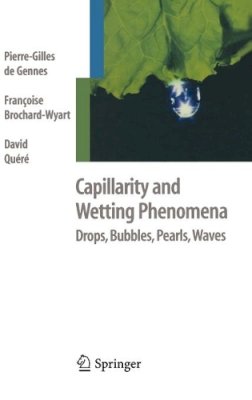
Stock image for illustration purposes only - book cover, edition or condition may vary.
Capillarity and Wetting Phenomena
Pierre-Gilles de Gennes
FREE Delivery in Ireland
Description for Capillarity and Wetting Phenomena
Hardcover. The study of capillarity is in the midst of a veritable explosion. What is offered here is not a comprehensive review of the latest research but rather a compendium of principles designed for the undergraduate student and for readers interested in the physics underlying these phenomena. Num Pages: 292 pages, 7 black & white tables, biography. BIC Classification: PNRX. Category: (G) General (US: Trade). Dimension: 243 x 166 x 31. Weight in Grams: 600.
As I glance out my window in the early morning, I can see beads of droplets gracing a spider web. The film of dew that has settled on the threads is unstable and breaks up spontaneously into droplets. This phenomenon has implications for the treatment of textile fibers (the process known as "oiling"), glass, and carbon. It is no less important when applying mascara! I take my morning shower. The moment I step out, I dry off by way of evaporation (which makes me feel cold) and by dewetting (the process by which dry areas form spontaneously and expand on ... Read moremy skin). As I rush into my car under a pelting rain, my attention is caught by small drops stuck on my windshield. I also notice larger drops rolling down and others larger still that, like snails, leave behind them a trail of water. I ask myself what the difference is between these rolling drops and grains of sand tumbling down an incline. I wonder why the smallest drops remain stuck. The answers to such questions do help car manufacturers treat the surface of glass and adjust the tilt of windshields. Show Less
Product Details
Publisher
Springer-Verlag New York Inc. United States
Place of Publication
New York, NY, United States
Shipping Time
Usually ships in 15 to 20 working days
Reviews for Capillarity and Wetting Phenomena
From the reviews: Choice Review by P. R. Douville, emeritus, Central Connecticut State University "You are an intelligent spider sitting on your web. Early morning light forms tiny rainbows as it passes through the beads of dew strung along the filaments composing your hard-earned handiwork. Why beads? What happened to the water in between ... Read moreeach drop? To answer this question, our eight-legged intellectual must first gain an understanding of how liquids such as water actually wet surfaces and why such liquids fail to wet other surfaces. The problem encompasses such subjects as liquids rising up capillary tubes, paint spreading on solid surfaces or liquids spreading on other liquids, the fascinating subject of bubble formation and stability, and why water streams down some surfaces and forms droplets on other surfaces. De Gennes (Collège ((College) de France; Institute Curie), Brochard-Wyart (Institut Curie), and Quéré (Quere) (Collège ((College) deFrance) have written an excellent treatise on these phenomena that opens with a very poetic introduction relating esoteric concepts to everyday observations, and includes chapter references, historical sketches, and a very good discussion of each problem at chapter beginnings. For readers with backgrounds in mathematics, physics, and chemistry, although it is not beyond advanced undergraduates in the sciences and technological fields. Summing Up: Highly recommended. Upper-division undergraduates through professionals; two-year technical program students." "This book is designed as an elementary introduction to the conceptual framework used in research on wetting/dewetting processes and related capillary phenomena. … a simple and inspiring style of writing allows the authors to ‘convey the sense of curiosity and joy’ that unites researchers in this area … . The range of topics covered and a host of physical ideas and principles the authors describe as guidelines in the field are likely to make this book interesting to a wide audience … ." (Dr. Y. D. Shikhmurzaev, Contemporary Physics, Vol. 46 (1), 2005) "Capillarity refers to the study of surface phenomena involving at least one liquid phase. … This book brings together (almost) everything which is known in a single volume. In view of the fact that the history of capillarity covers several centuries, this is a real ‘tour de force’. … It contains a wealth of practical information about a very large variety of surface phenomena. … This book should be of interest to a large variety of scientists (not only physicists)." (Marc Baus, Physicalia, Vol. 57 (3), 2005) "Capillarity and Wetting Phenomena: Drops, Bubbles, Pearls, Waves is a translation of the earlier French Gouttes, Bulles, Perles et Ondes … . It has been wonderfully translated by Axel Reisinger. The English is fully fluent and idiomatic … . The book can be read with pleasure and profit by the uninitiated, but it is also a valuable - andeven an indispensable reference work for the expert. … contains a whole bookshelf of information – all of it useful and much of it fascinating." (Benjamin Widom, Physics Today, December, 2004) "De Gennes (Collège ((College) de France; Institute Curie), Brochard-Wyart (Institut Curie), and Quéré (Quere) (Collège (College) de France) have written an excellent treatise … with a very poetic introduction relating esoteric concepts to everyday observations, and includes chapter references, historical sketches, and a very good discussion of each problem at chapter beginnings. … Summing Up: Highly recommended. Upper-division undergraduates through professionals: two-year technical program students." (P. R. Douville, CHOICE, May, 2004) "The whole book is in the same spirit, which is very enjoyable … . Thus it contains many illuminating examples and sketches … . it will also act as a reference for those working in the field. In conclusion, the intended readers of this book, whether they be soft matter students or scientists or simply the curious, should find therein not just a very good source of information but also an impressive collection of exciting and simple explanations of very complex phenomena." (Dr. Roberto Cerbino, Europhysics News, Vol. 37 (1), 2006) Show Less

.png)